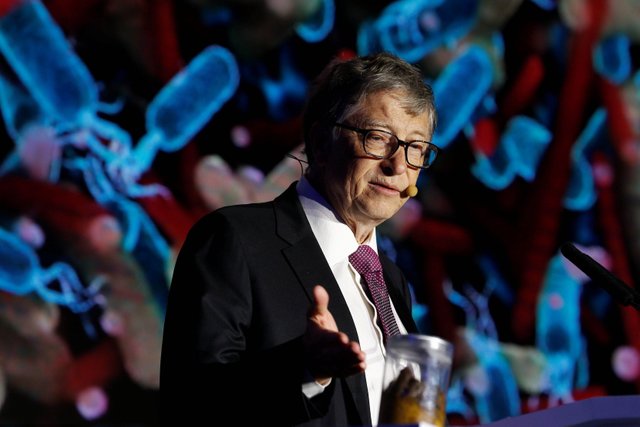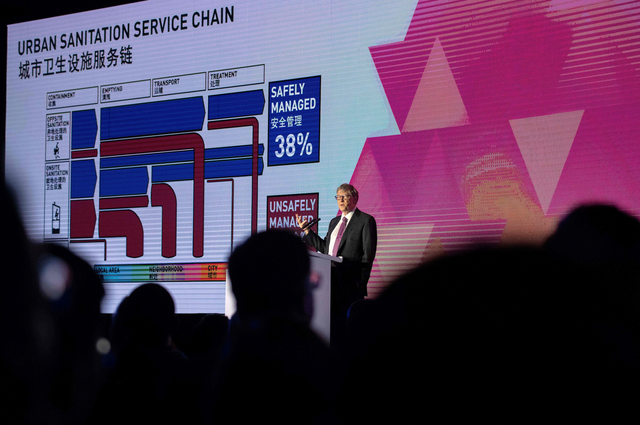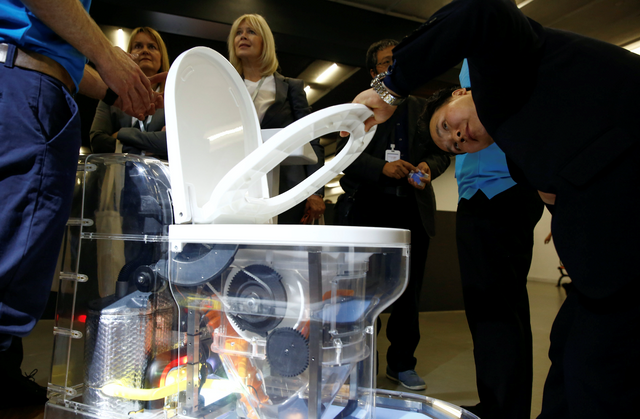
After stopping full-time work at Microsoft, why did Bill Gates insist on investing in the human toilet revolution? And what kind of new generation toilet do we need?
In front of the podium, Bill Gates raised a beaker to show the audience what was in it. It is not a new material, new technology, but human feces carrying two billion trillion of Herella, rotavirus, and 100,000 parasite eggs.
Gates stared at the half of the manure and explained to the listener, "In places where there are no safety and sanitation facilities... it is these pathogens that cause diarrhea, cholera, typhoid and other diseases... resulting in nearly half a million under five years of age each year. The death of a child."
This is the New Generation Toilets Expo, which is one of the few public events that Gates visited in November for four days. The exhibition was jointly organized by the Gates Foundation, the China Council for the Promotion of International Trade, and the China International Chamber of Commerce. The venue is located at the Beijing Guardian Art Center.
In this three-story, 3,000-square-meter building, more than 20 new toilets from 16 universities and research institutions around the world are on display. This is also a summary of the results of the Gates Foundation's seven-year challenge to launch a toilet innovation.
The new toilets are different in color, some are placed on the stand one meter high, and the two toilets under the seat and the squat are complex dirt treatment systems; some are made of transparent shells, parts of the toilet The difference in function is indicated by colored lights... What they have in common is the use of high technology to eliminate harmful pathogens and turn waste into waste.
In seven years, the Gates Foundation has invested more than $200 million to find the best solution for the new generation of toilets. After stopping full-time work at Microsoft, why did Bill Gates insist on investing in the human toilet revolution? And what kind of new generation toilet do we need? What kind of future will the so-called "toilet revolution" be?

Gates and the renovation of the toilet
"I don't need a new toilet. The toilet in our house is perfect enough." This is the reaction of many people when they mentioned the "toilet revolution." In response to this assertion, Liu Dong, senior project officer of the Gates Foundation, stressed that the toilet is not the end of the feces, but the starting point. Behind the convenience of the toilet, a whole casing network system is maintained.
The pipe network system consists of three parts: collection, transportation and processing. The government has built this public product, and the user pays the model to ensure the normal operation of the system. Liu Dong said: "Although we usually can't see it, it is indeed a kind of luck for us."
A set of data shows that 4.5 billion people worldwide do not have access to safe sanitation; 2.3 billion people do not have access to the most basic health services; in the past five years, the penetration rate of safety and health solutions has increased by only 3%.
In 2011, Professor Zheng Yuling from the University of Toronto joined the Gates Foundation's toilet innovation program. Previously, she was mainly engaged in research in the field of chemical engineering – most of which were problems in “first world” countries, such as drug transportation and biomaterials. When she began to study environmental health issues, some data and information shocked her.
For example, about 1 billion people can only "open the toilet". Excreta of more than 4 billion people (including many areas with sewage treatment systems) are not safely disposed of, which will eventually pollute the environment and endanger human health. "Most people don't know about it and don't want to think about it." Zheng Yuling said, "Yes, because we don't want to think about it."
As early as 2009, Gates had begun to think about human "feces". He once asked some scientists and engineers whether it is possible to use a more economical method to eliminate pathogens, which can meet the needs of rapid urban development, without connecting sewers, and saving the shortage of hydropower resources.
Some people suspect that this will not work. Gates will say in his own words, "At the beginning of my business, I felt that computers can only be the mainframes that big companies and governments can afford. This is everyone's cognitive inertia of computers. But at the time we had some people. I don't think so. We dream of developing a personal computer that everyone can use... Now everyone can't imagine what the world of the mainframe era looks like."
Gates believes that in the public health field, new technology can change the toilet environment of all mankind. Therefore, he vigorously promoted and promoted. In his personal blog, Gate Notes, Gates published 20 articles and videos on toilet issues, documenting his visits to the toilets in the United States, India, and China. In 2015, at a manure treatment plant in Washington, Gates took the lens and drunk the pure water produced by the factory from the feces

" self-sufficient " new generation toilet
There are many ways to revolutionize the toilet. For example, a progressive change method. Under the condition of not changing the overall pipe network system, we will optimize all aspects of the manure treatment. "It is like using a new type of suction truck in the transportation process to ensure that it will not run out of dripping." Liu Dong introduced.
Another way of thinking is to combine the three links of collection, transportation and processing into a new type of product. This is the new generation of toilets on display at the show. It is a new generation toilet that can handle waste and self-sufficiency.
The invention brought by the California Institute of Technology is the ECO-SAN processing system. It can use solar energy to extract pure water from the feces for toilet flushing, using an electrochemical reactor to decompose water and excreta into hydrogen and fertilizer, hydrogen can be used as an energy source for hydrogen fuel cells, and fertilizer can be used for agricultural cultivation. This system is available for 50-800 people per day.
Cranfield University has introduced a new type of dry-burning toilet with a toilet in front, a new waterless flushing method, and all waste disposal components are installed in the base. The back end extracts the solid waste through a specially designed screw, then dries and burns while preheating the liquid and purifying it with a hydrophobic membrane. Different from the design of Caltech, this product is available for families and can be used by up to 10 people per day.
The new toilet brought by Professor Zheng Yuling from the University of Toronto is also designed for unit families. The prototype exhibited at the New Generation Toilet Expo, the front end is a squat toilet, and the rear end is equipped with a solid-liquid disinfection device. The advantage of this device is the calcination technology that can continuously and stably generate heat when handling fecal matter, and the pasteurization of the liquid by recovering the steam heat energy when the solid is dried.
In 2011, after receiving the invitation for the new generation of toilets, Zheng Xiaoling submitted the initial plan only one month. "Because the time spent is too small, so I don't think much about maturity." Zheng Yuling said to Geek Park. For seven years, they have been modifying the program, and it is now the fourth generation.
"Developing this eco-friendly toilet is both challenging and exciting." Zheng Yuling said, "It is one thing to prove a concept in an academic laboratory, but to build a prototype and develop it so that it can be used in an ordinary family. It is much harder to use.” Currently, with the assistance of the Gates Foundation, they are placing their own products on a university construction site in Coimbatore, India, for on-site testing.
In the future, homes, units, factories, parks and other places will be the use of new generation toilets. However, the problem of high prices of these products has not yet found an effective solution. Participating in the New Generation Toilet Expo, Zheng Xiaoling also mentioned that they hope to get more partners at the exhibition, in order to have more suitable commercial cooperation in equipment manufacturing and pollutant treatment technology.
In order to attract more power to join, in the speech of the New Generation Toilet Expo, Gates even compared the problem of solving the toilet to a huge business opportunity. He said: "If you are from a company, you must have realized that with the continuous advancement of technology, how to meet the safety of the toilets of 4.5 billion people has enormous business opportunities. Such a large business opportunity is not always there."